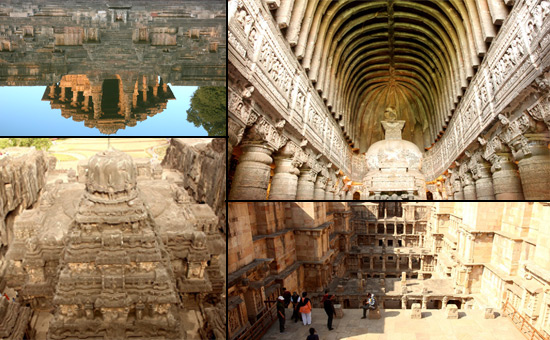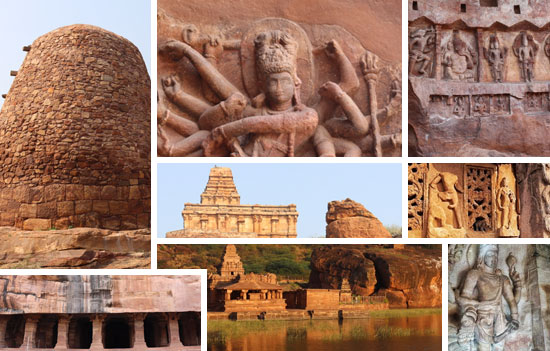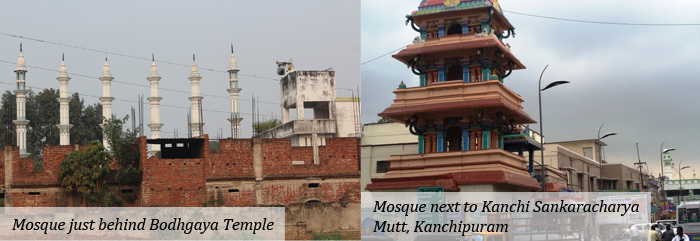- Some learned believe that raising of Gyanvapi mosque matter will disturb long existing Hindu Muslim unity. Know details of riots during British rule & post-Independence, Bomb Blasts since 1993 & Hindu Muslim relations in 19-20th century. Om Shanti.
Ever since the current legal battle on Kashi Vishwanath/Gyanvapi started some learned are saying that for the sake of Hindu Muslim unity let status quo remain. Others imply that Hindu Muslims always lived in peace. Without intending to be provocative this article seeks to jog your memory.
Firstly,
why is this article talking about communal issues?
What appears to be communal today is a part of history. Freedom-fighter K M Munshi wrote, “Another problem that we have to consider is the persistent demand for the rewriting of history to foster communal amity. To my mind, nothing can be a greater mistake.” 1 pg iii
Read
about riots (not an exhaustive list) in two parts. During British rule (includes
Hindu Muslim relations in 19th and early 20th century) and
post-Independence. Lastly, details of Bomb Blasts (intent is similar to riot).
When Muslims ruled India, one never heard of the word riot. There were battles fought by Hindus to liberate their country from foreign invaders. These battles accentuated during and after Aurangzeb’s rule. Marathas led the charge. The 18th
century is thus called the Maratha
Century.
1. During British rule - Hindu
Muslim relations in the 19th century
Here
is a precis of a chapter from Volume 10 of The
History and Culture of Indian People. 3
It
must be admitted that the roots of the cleavage lay deep in the soil and it was
already manifest even in the 19th century. Differences between the
elites grew even before fillip was given to it either by the Aligarh Movement
or the Divide and Rule policy of the British. Relations between the masses
though normally cordial and calm on the surface had not lost their tendency to
erupt. Pg. 325
Also read About
Aligarh Movement and How British accentuated the divide
In
October 1809, a Hindu mob stormed the great mosque of Aurangzeb in Kashi. It is
reported that a large number of Muslims were put to death. In 1820, the Muslims
assaulted a Durga Puja procession in Calcutta. Communal riots during the
outbreak of 1857. Hindu Muslim riots with heavy casualties occurred in Bareilly
and other localities in U.P. during 1871-72. Pg. 326
Communal
riots grew in volume and frequency, particularly between 1885 and 1893. It is
perhaps not unreasonable to assume that this increased tension between the
communities was a direct consequence of the growing cleavage between their
leaders. Pg. 327
Thus,
towards about 1905 Hindus and Muslims represented almost two opposite camps in
politics, the ground was prepared throughout the 19th century, by
the communal outlook of the Muslims, both in their general political evolution
as well as in the Wahabi
and Aligarh movements. Pg. 327
Having said that, it must be remembered that the two movements referred to above did not represent the Muslim community as a whole. Masses were mostly indifferent and a number of distinguished Muslims co-operated in political matters with Hindus. Secondly, if the Muslims were communal and lacking in an all India outlook, the Hindus were partly responsible. While all-India outlook was not altogether absent, there was a general feeling among large sections of Hindus and Muslims that they formed two separate political units or nations.
Thirdly,
one must know why Hindus gradually outgrew this narrow tendency and imbibed a
national spirit whilst Muslims failed to do so. The Hindus had a start of
atleast half a century over the Muslims in their political evolution but there
were difficulties in Muslims adopting a national outlook.
Their condition was best
stated by a liberal,
R M Sayani in his Presidential address at the 12th session of the Congress held in 1896. Excerpts: “Before the advent of the British in India, the Muslims were the rulers of the country. The rulers and their chiefs were Muslims so were the great landlords and officials. The court language was their own (Persian was the official language of India till 1842). Every place of trust and responsibility, or carrying influence and high emoluments, was theirs by birth right. The Hindus did occupy the same position but were tenants-at-will of the Muslims. The Muslims had complete access to the rulers and chief. By a stroke of misfortune, the Muslims had to abdicate their position and descend to the level of their Hindu fellow-countrymen. The Muslims resented the treatment.”
“Meanwhile the British introduced English education into the country. This required hard application and industry. The Hindus were used to this, as under Muslim rule, they had practically to master a foreign tongue, and so easily took to new education. But the Muslim had not yet become accustomed to this sort of thing. Ignorance and apathy seized hold of them while the fall of their former greatness rankled in their hearts.” Pg. 296
Muslims
could have joined Hindu political demands but what was the inducement. In
social and religious matters a deep gulf existed. Name of Shivaji was an
inspiration for Hindus who held Aurangzeb in open contempt. The reverse was the
case with Muslims.
Yet
Hindu Muslim unity into one nation was possible. However, Hindu leaders had no
patience to listen sympathetically to the grievances of the Muslims, which
could explain their attitude towards the Hindus.
The
indifference of the Muslim masses to all political questions probably
contributed to the mistaken notion of the Hindus about Muslim attitude.
Confronted by the opposition of educated Muslims, they consoled themselves with
the idea that the Muslim masses were not with the latter. Pg. 331
 There is more to India than the Taj
There is more to India than the Taj
Hindu Muslim Relations 1919-1928
Here
is a precis of a chapter from Volume 11 of The
History and Culture of Indian People. 1
The
suspension of the non-cooperation movement chilled the enthusiasm of the
Khilafatists and when the Caliphate was abolished the Khilafat Movement died a
natural death. Almost as soon as the non-cooperation movement died down, old
feuds between Hindus and Muslims recurred. At the back of it lay the old Muslim policy of deriving communal or personal
advantages by cooperating with the British against the Hindus.
Early
in 1923, there were serious communal clashes in Multan and Amritsar. Later in
the year, Muslims started a definite communal movement called Tanzeem and Tabligh to organise Muslims as a virile community. In response,
Hindus started a Sangathan movement
for promoting physical culture and removing social abuses. Swami Shraddhananda
started the Suddhi (purification)
movement to bring back Hindus who were converted to Muslim. The Sangathan and
Suddhi movements caused a serious rift between the two communities. Pg. 425
Serious
communal riots vitiated the political atmosphere of India from 1923 onwards.
One of the worst riots broke out in Calcutta in May 1923. There were a series
of riots on 15 July, 1924 on Bakr-id. The most serious one took place in Delhi.
Pg. 427
Generally, communal riots were confined to British territory and the Indian States were free from them. A serious in 1924, in Gulbarga, in Nizam’s territory, was an exception.
The
most serious outbreak occurred in Kohat, in North West Frontier Province, a
predominantly Muslim area. The destruction caused forced the Hindu and Sikh
population to leave Kohat for Rawalpindi and other places in Punjab. There were
other communal riots, notably one at Lakhnau on 13 and 14 September. Pg. 428-433.
In
1925 and 1926 Hindu Muslim relations continued to deteriorate, the Bakri-id
ceremony caused serious riots in Delhi, Amdavad and Calcutta. No less than 16
communal riots took place in 1925, the worst being in Delhi, Aligarh, Sholapur
and Arvi. The most serious riot in 1926 took place in Calcutta in April over
the question of music before a mosque. In 1926, Swami Shraddhananda died after
being stabbed by a Muslim. Pg. 434-35.
It
has been calculated that between 1922 and 1927, 450 lives were lost and 5,000
persons injured in communal riots. Pg.
436
Also read Direct Action 1946 – Calcutta Horror

Ambedkar gives details of Hindu Muslim riots during 1920 to 1940
In the aftermath of Gandhi’s efforts at Hindu-Muslim unity during the Khilafat Movement Dr. Ambedkar examined Hindu-Muslim relations between 1920 and 1940 in Thoughts
on Pakistan (published 1941). Here are excerpts: 2
1920 Moplah
Rebellion was essentially a rebellion against the British government but Hindus
were raped, converted and killed, foul outrages upon women. Pg. 159
1921-22 Muharram
celebrations had serious riots in Bengal & Punjab. Pg. 159
1922-23 was a
peaceful year.
1923-24 Riot in
Kohat City. Hindus had to evacuate city, other riots too. Pg. 160.
1925-26 Antagonisms
between Hindus Muslims became widespread. Deplorable rioting in Calcutta. Riots
in United Provinces, Bombay Presidency. Pg. 160-161.
1926-27 was one
continuous period of Communal riots. Major disorders in Delhi, Punjab, Bengal
& United Provinces. Pg. 163.
40 riots took place during the 12
months ending 1/4/1927. Pg. 163.
In 1927, the Afridis and
Shinwaris were called upon to expel all the Hindus living in the neighborhood
of the Khyber Pass. Pg. 166
1927-28 Between
April & Sept 25 riots were reported. Places occurred United Provinces,
Bombay Presidency, Punjab, Central provinces. Most serious report was in
Lahore. Also economic boycott was freely advocated in the British frontier
districts but the movement met with little success. Hindus were expelled from
Khyber Pass. Pg. 164, 166.
1928-29 was relatively
more peaceful than 1927-28. Although number of riots were fewer casualties were
swelled by the Bombay riots. Pg. 167
1929-30 Riots
were less frequent. Pg. 169
1930-31 There
occurred innumerable communal disturbances mostly due to the Muslim opposition
to the Civil Disobedience Movement started by the Congress in that year.
Bengal, Assam, Madras, Lahore, Rawalpindi, Bihar, Orissa were some of the
places where disturbances occurred. Pg. 170
1931-32 The
progress of constitutional discussions had a definite reaction in that it bred
certain nervousness among the Muslims as to their position under a constitution
functioning on the majority principle. Within 3 weeks of the Gandhi-Irwin Pact
perceived by the Muslims to give a privileged position to the Congress occurred
the savage communal riots at Cawanpore. Pg. 174
1932-33 Was
relatively free from communal agitations & disturbances. This was doubtless
in some measure due to the suppression of lawlessness generally and removal of
uncertainty in regard to the position of Muslims under the new constitution.
Pg. 175
1933-34 Communal
tension kept on increasing. Riots occurred at Cawanpore, Benaras, Lahore,
Peshawar, Ayodhya, and Cannanore in Madras etc. Pg. 175
1934-35 serious
trouble arose in Lahore, Karachi, Secunderabad. Pg. 176, 178.
1936 There were
four communal riots namely Firozabad in Agra district, Poona, Bombay and
Jamalpur in Monghyr district. Pg. 178,179.
1937 Was full of
communal disturbances. Panipat, Central Provinces, Punjab, Sind. Pg.
179
1938 Had two riots
in Allahabad and Bombay. Pg. 179
1939 Saw 6 riots
in Asansol, Benaras, Cawanpore amongst others. Pg. 179
Also read Who
was responsible for Partition?
Ambedkar
wrote that those who believed in Hindu Muslim unity believed in the efficacy of
the Central Government to mould diverse set of peoples into one nation. Second,
they feel the satisfaction of Muslim demands will be sure means of achieving
Hindu-Muslim unity. Pg. 183
 Badami, Aihole, Pattadakal are wonders of Chalukyan architecture.
Badami, Aihole, Pattadakal are wonders of Chalukyan architecture.
2. Post-Independence
The
March 5, 2012 issue of Outlook had an article by Saba Naqvi and Smruti Koppilar titled ‘A Beat Asleep’ which gave details of riots since 1967 that had a toll of atleast 5. Data by Alka Gupta.
Outlook - “58 major communal riots in 47 places since 1967. Ten in South India, 12 in East, 16 in West and 20 in North India. Since 1964, Ahmedabad has seen five major riots and Hyderabad four. The 1990s saw the most riots in the last five decades: 23. The 1970s saw seven riots, the 1980s 14; the 2000s have seen 13. Total toll: 12,828 (South 597, West 3,426, East 3,581 and North 5,224). In 1964, a wave of rioting in Calcutta (now Kolkata), Jamshedpur and Rourkela killed 2,500.”
Table 1-Details of Communal
riots since 1967
|
Year
|
Place
|
|
1967
|
Hatia, Ranchi
|
|
1968
|
Karimganj-Assam
|
|
1969
|
Ahmedabad
|
|
1970
|
Bhiwandi-Maharashtra
|
|
1970
|
Jalgaon-Maharashtra
|
|
1977
|
Varanasi
|
|
1978
|
Sambhal-UP
|
|
1978
|
Hyderabad
|
|
1978
|
Aligarh
|
|
1979
|
Jamshedpur
|
|
1980
|
Moradabad
|
|
1981
|
Biharsharif
|
|
1982
|
Meerut
|
|
1982
|
Baroda
|
|
1983
|
Nellie, Assam
|
|
1983
|
Hyderabad
|
|
1984
|
Bhiwandi-Maharashtra
|
|
1985
|
Ahmedabad
|
|
1986
|
Ahmedabad
|
|
1987
|
Meerut
|
|
1989
|
Bhadrak-Odisha
|
|
1989
|
Indore
|
|
1989
|
Bhagalpur
|
|
1990
|
Ahmedabad
|
|
1990
|
Jaipur
|
|
1990
|
Jodhpur
|
|
1990
|
Lucknow
|
|
1990
|
Chandni Chowk,
Delhi
|
|
1990
|
Hailakandl-Assam
|
|
1990
|
Patna
|
|
1990
|
Hyderabad
|
|
1990
|
Agra
|
|
1990
|
Hassan, Mandya,
Mysore
|
|
1990
|
Hyderabad
|
|
1990
|
Aligarh
|
|
1991
|
Baroda
|
|
1991
|
Meerut
|
|
1992
|
Sitamarhi-Bihar
|
|
1992
|
Surat
|
|
1992
|
Malpura-Andhra
Pradesh
|
|
1992
|
Kanpur
|
|
1992
|
Bhopal
|
|
1992/93
|
Mumbai
|
|
1997
|
Coimbatore
|
|
1998
|
Coimbatore
|
|
1998
|
Surathkal-Karnataka
|
|
2001
|
Nalanda-Bihar
|
|
2001
|
Kanpur
|
|
2011
|
Malegaon
|
|
2002
|
Gujarat
|
|
202
|
Marad-Kerala
|
|
2006
|
Aligarh
|
|
2006
|
Baroda
|
|
2007
|
Kandhanmal-Odisha
|
|
2008
|
Bhainsa-Andhra
Pradesh
|
|
2009
|
Miraj, Karnataka
|
|
2011
|
Bharatpur
|
Source and credits Outlook magazine. Only riots with a
toll of 5 or more included. Death due to bomb blasts excluded.
Note
there is a history of communal conflict. Assam 2012, several riots in Uttar Pradesh and rioting in Rajasthan are part of the same story. Add
recent riots in Karauli,
Rajasthan and 2013 riots in Muzzafarnagar
.
Also read How
Azaan is increasing the Hindu Muslim Divide
 Mosque near prominent
temples & Azaan is increasing the divide.
Mosque near prominent
temples & Azaan is increasing the divide.
3. Why Riots are similar to Bomb Blasts?
Like in
riots the intent behind exploding bombs is to destroy property and/or kill
members of the other community. It also creates fear. Table 2 give details of
blasts from 1993 to 2008.
Table 2-Terror attacks/blasts 1993-2008 in which more than 25 lives were lost
|
No
|
Year
|
Place
|
|
1
|
1993
|
Mumbai
|
|
2
|
2003
|
Mumbai
Taj/Zaveri Bazaar
|
|
3
|
2006
|
Mumbai Trains
|
|
4
|
2008
|
26/11/ Terror
|
|
5
|
2002
|
Gandhinagar
|
|
6
|
2005
|
Delhi Paharganj
|
|
7
|
2006
|
Varanasi
|
|
8
|
2006
|
Malegaon
|
|
9
|
2007
|
Samjhauta
Express
|
|
10
|
2007
|
Panipat
|
|
11
|
2007
|
Hyderabad
|
|
12
|
2008
|
Jaipur
|
|
13
|
2008
|
Ahmedabad
|
|
14
|
2008
|
Gauhati
|
Excludes dead in the
Khalistani/Kashmiri terrorist movements and ULFA violence
From
the above data you will see the riots occurred frequently. Surely, Hindus and
Muslims can live in peace. How needs a separate article.
Every
effort is made to provide correct data. Errors if any are unintended and
without malafide intent. Read, reflect and decide for yourself. Om Shanti.
References
1.
History and Culture of the Indian People Volume 11 published by The Bharatiya
Vidya Bhavan.
2.
Thoughts on Pakistan by Dr Ambedkar.
3.
History and Culture of the Indian People Volume 10 published by The Bharatiya
Vidya Bhavan.